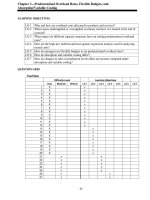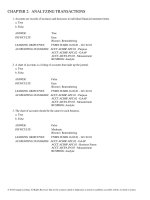Corporate finance accounting 14e by warren reeve duchac chapter 3
Bạn đang xem bản rút gọn của tài liệu. Xem và tải ngay bản đầy đủ của tài liệu tại đây (651.47 KB, 20 trang )
Chapter
3
The Adjusting Process
Corporate Financial
Accounting
14e
Warren
Reeve
Duchac
®
© 2017 Cengage Learning . May not be scanned, copied or duplicated, or posted to a publicly accessible website, in whole or in part.
Accrual and Cash Basis of Accounting
(slide 1 of 2)
•
Under the accrual basis of accounting, revenues are reported on the income
statement in the period in which a service has been performed or a product has
been delivered.
o
•
Cash may or may not be received from customers during this period.
The accrual basis of accounting also requires expenses to be recorded when they
are incurred, not necessarily when cash is paid.
•
Generally accepted accounting principles (GAAP) require the accrual basis of
accounting.
®
© 2017 Cengage Learning . May not be scanned, copied or duplicated, or posted to a publicly accessible website, in whole or in part.
Accrual and Cash Basis of Accounting
(slide 2 of 2)
•
Under the cash basis of accounting, revenues and expenses are reported on the
income statement in the period in which cash is received or paid.
•
Most individuals and small service businesses may use the cash basis of
accounting. For most large businesses, however, the cash basis will not provide
accurate financial statements for user needs.
®
© 2017 Cengage Learning . May not be scanned, copied or duplicated, or posted to a publicly accessible website, in whole or in part.
Revenue and Expense Recognition
(slide 1 of 2)
•
Under the revenue recognition principle, revenues are recorded when services
have been performed or products have been delivered to customers.
o
Revenue is normally measured as the assets received, such as cash or accounts receivable.
o
The process of recognizing revenues is called revenue recognition.
®
© 2017 Cengage Learning . May not be scanned, copied or duplicated, or posted to a publicly accessible website, in whole or in part.
Revenue and Expense Recognition
(slide 2 of 2)
•
Under the expense recognition principle, the expenses incurred in generating
revenue must be reported in the same period as the related revenue.
o
This is also called the matching principle.
By matching revenues and expenses, net income or loss for the period is properly reported on the income
statement.
Adjusting entries are required to properly match revenues and expenses.
®
© 2017 Cengage Learning . May not be scanned, copied or duplicated, or posted to a publicly accessible website, in whole or in part.
The Adjusting Process
(slide 1 of 3)
•
At the end of an accounting period, an unadjusted trial balance is prepared to verify
that the total debit balances equal the total credit balances.
•
Many of these account balances are reported in the financial statements without
change.
®
© 2017 Cengage Learning . May not be scanned, copied or duplicated, or posted to a publicly accessible website, in whole or in part.
The Adjusting Process
(slide 2 of 3)
•
Some accounts on the unadjusted trial balance, however, require adjustments for
the following reasons:
o
Some expenses are not recorded daily.
o
Some revenues and expenses are incurred as time passes rather than as separate
transactions.
o
Some revenues and expenses may be unrecorded at the end of the accounting period.
®
© 2017 Cengage Learning . May not be scanned, copied or duplicated, or posted to a publicly accessible website, in whole or in part.
The Adjusting Process
(slide 3 of 3)
•
The analysis and updating of accounts at the end of the period before the financial
statements are prepared is called the adjusting process.
•
The journal entries that bring the accounts up to date at the end of the accounting
period are called adjusting entries.
o
All adjusting entries affect at least one income statement account and one balance sheet
account.
Thus, an adjusting entry will always involve a revenue or an expense account and an asset or a liability
account.
®
© 2017 Cengage Learning . May not be scanned, copied or duplicated, or posted to a publicly accessible website, in whole or in part.
Types of Accounts Requiring Adjustment
•
The two general classifications of accounts requiring adjustment are as follows:
o
Accruals
o
Deferrals
®
© 2017 Cengage Learning . May not be scanned, copied or duplicated, or posted to a publicly accessible website, in whole or in part.
Types of Accounts Requiring Adjustment: Accruals
•
An accrual occurs when revenue has been earned or an expense has been
incurred but has not been recorded.
o
If the accrual is for revenue, the adjusting entry debits an asset (Accounts Receivable) and
credits a revenue account.
o
If the accrual is for an expense, the adjusting entry debits an expense account and credits a
related liability account such as Accounts Payable or Wages Payable.
®
© 2017 Cengage Learning . May not be scanned, copied or duplicated, or posted to a publicly accessible website, in whole or in part.
Types of Accounts Requiring Adjustment: Deferrals
•
A deferral occurs when cash related to a future revenue or expense has been initially recorded as
a liability or an asset.
o
If the cash received is related to future revenue, it is initially recorded as a liability called unearned revenue.
The adjusting entry in the period when the revenue is earned debits an unearned revenue account and credits a
revenue account.
o
If the cash paid is related to a future expense, it is initially recorded as an asset called prepaid expense.
The adjusting entry in the period when the expense is incurred debits an expense account and credits a prepaid
expense (asset) account.
®
© 2017 Cengage Learning . May not be scanned, copied or duplicated, or posted to a publicly accessible website, in whole or in part.
Depreciation Expense
(slide 1 of 7)
•
Fixed assets, or plant assets, are physical resources that are owned and used by
a business and are permanent or have a long life.
o
Examples of fixed assets include land, buildings, and equipment.
®
© 2017 Cengage Learning . May not be scanned, copied or duplicated, or posted to a publicly accessible website, in whole or in part.
Depreciation Expense
(slide 2 of 7)
•
As time passes, a fixed asset loses its ability to provide useful services.
o
This decrease in usefulness is called depreciation.
®
© 2017 Cengage Learning . May not be scanned, copied or duplicated, or posted to a publicly accessible website, in whole or in part.
Depreciation Expense
(slide 3 of 7)
•
All fixed assets, except land, lose their usefulness and, thus, are said to
depreciate.
o
As a fixed asset depreciates, a portion of its cost should be recorded as an expense.
This periodic expense is called depreciation expense.
®
© 2017 Cengage Learning . May not be scanned, copied or duplicated, or posted to a publicly accessible website, in whole or in part.
Depreciation Expense
(slide 4 of 7)
•
The adjusting entry to record depreciation expense is similar to the adjusting entry
for supplies used.
o
The depreciation expense account is increased (debited) for the amount of depreciation.
o
However, the fixed asset account is not decreased (credited).
This is because both the original cost of a fixed asset and the depreciation recorded since its purchase
are reported on the balance sheet.
Instead, an account entitled Accumulated Depreciation is increased (credited).
®
© 2017 Cengage Learning . May not be scanned, copied or duplicated, or posted to a publicly accessible website, in whole or in part.
Depreciation Expense
(slide 5 of 7)
•
Accumulated depreciation accounts are called contra accounts, or contra asset
accounts.
o
This is because accumulated depreciation accounts are deducted from their related fixed
asset accounts on the balance sheet.
o
The normal balance of a contra account is opposite to the account from which it is deducted.
o
Because the normal balance of a fixed asset account is a debit, the normal balance of an
accumulated depreciation account is a credit.
®
© 2017 Cengage Learning . May not be scanned, copied or duplicated, or posted to a publicly accessible website, in whole or in part.
Depreciation Expense
(slide 6 of 7)
•
The normal titles for fixed asset accounts and their related contra asset accounts
are as follows:
®
© 2017 Cengage Learning . May not be scanned, copied or duplicated, or posted to a publicly accessible website, in whole or in part.
Depreciation Expense
(slide 7 of 7)
•
The difference between the original cost of the office equipment and the balance in
the accumulated depreciation—office equipment account is called the book value
of the asset (or net book value).
•
It is computed as follows:
Book Value of Asset = Cost of the Asset – Accumulated Depreciation of Asset
®
© 2017 Cengage Learning . May not be scanned, copied or duplicated, or posted to a publicly accessible website, in whole or in part.
Adjusted Trial Balance
•
•
After the adjusting entries are posted, an adjusted trial balance is prepared.
The adjusted trial balance verifies the equality of the total debit and credit balances
before the financial statements are prepared.
®
© 2017 Cengage Learning . May not be scanned, copied or duplicated, or posted to a publicly accessible website, in whole or in part.
Analysis for Decision Making:
Vertical Analysis
•
Comparing each item in a financial statement with a total amount from the same
statement is referred to as vertical analysis.
o
In vertical analysis of a balance sheet, each asset item is stated as a percent of the total
assets. Each liability and stockholders’ equity item is stated as a percent of total liabilities
and stockholders’ equity.
o
In vertical analysis of an income statement, each item is stated as a percent of revenues or
fees earned.
®
© 2017 Cengage Learning . May not be scanned, copied or duplicated, or posted to a publicly accessible website, in whole or in part.









